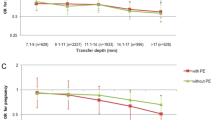Abstract
Purpose
To evaluate the effects of myometrial thickening on the outcomes of in vitro fertilization and embryo transfer (IVF-ET).
Methods
Four hundred thirteen patients, a total of 551 IVF-ET cycles, were divided into group A (<2.00 cm), group B (2.00–2.49 cm), and group C (≥2.50 cm) based on myometrial thickness.
Results
The implantation, clinical pregnancy, and live birth rates were significantly lower in group C. The abortion rates were significantly higher in group C. Among patients in group B, cases with other sonographic findings suggestive of adenomyosis, such as myometrial striations, heterogeneous myometrium, myometrial cysts, and poor definition of the endometrial–myometrial junction showed lower implantation, clinical pregnancy, live birth rates, and higher abortion rates.
Conclusions
Myometrial thickening of more than 2.50 cm on TVUS exerts overall adverse effects on IVF-ET outcomes. Even with mild thickening (2.00–2.49 cm), the presence of sonographic findings suggestive of adenomyosis is associated with adverse outcomes of IVF-ET.
Similar content being viewed by others
References
Kido A, Togashi A, Koyama T, Yamaoka T, Fugiwara T, Fujii S. Diffusely enlarged uterus: evaluation with MR imaging. Radiographics. 2003;23:1423–39.
Matalliotakis IM, Kourtis AI, Panidis DK. Adenomyosis. Obstet Gynecol Clin North Am. 2003;30:63–82.
Wang PH, Su WH, Sheu BC, Liu WM. Adenomyosis and its variance: adenomyoma and female fertility. Taiwan J Obstet Gynecol. 2009;48:232–8.
Gordts S, Brosens JJ, Fusi L, Benagiano G, Brosens I. Uterine adenomyosis: a need for uniform terminology and consensus classification. Reprod Biomed Online. 2008;17:244–8.
Levgur M. Diagnosis of adenomyosis: a review. J Reprod Med. 2007;52:177–93.
Kepkep K, Tuncay YA, Göynümer G, Tutal E. Transvaginal sonography in the diagnosis of adenomyosis: which findings are most accurate? Ultrasound Obstet Gynecol. 2007;30:341–5.
Sun YL, Wang CB, Lee CY, Wun TH, Lin P, Lin YH, et al. Transvaginal sonographic criteria for the diagnosis of adenomyosis based on histopathologic correlation. Taiwan J Obstet Gynecol. 2010;49:40–4.
Dueholm M, Lundorf E. Transvaginal ultrasound or MRI for diagnosis of adenomyosis. Curr Opin Obstet Gynecol. 2007;19:505–12.
Bazot M, Cortez A, Darai E, Rouger J, Chopier J, Antoine JM, et al. Ultrasonography compared with magnetic resonance imaging for the diagnosis of adenomyosis: correlation with histopathology. Hum Reprod. 2001;16:2427–33.
Hulka CA, Hall DA, McCarthy K, Simeone J. Sonographic findings in patients with adenomyosis: can sonography assist in predicting extent of disease? Am J Roentgenol. 2002;179:379–83.
Reinhold C, Tafazoli F, Mehio A, Wang L, Atri M, Siegelman ES, et al. Uterine adenomyosis: endovaginal US and MR imaging features with histopathologic correlation. Radiographics. 1999;19:S147–60.
Zegers-Hochschild F, Adamson GD, de Mouzon J, Ishihara O, Mansour R, Nygren K, et al. International Committee for Monitoring Assisted Reproductive Technology (ICMART) and the World Health Organization (WHO) revised glossary of ART terminology, 2009. Hum Reprod. 2009;24:2683–7.
Anderson JR, Genadry R. Anatomy and embryology. In: Berek JS, editor. Berek & Novak’s gynecology. 14th ed. Philadelphia: Lippincott Williams & Wilkins; 2007. p. 75–127.
Levi CS, Lyons EA, Holt SC, Dashefsky SM. Normal anatomy of the female pelvis and transvaginal sonography. In: Callen PW, editor. Ultrasonography in obstetrics and gynecology. 5th ed. Philadelphia: Saunders; 2008. p. 887–918.
Traiman P, Saldiva P, Haiashi A, Franco M. Criteria for the diagnosis of diffuse uterine myohypertrophy. J Gynaecol Obstet. 1996;54:31–6.
Camargo F, Gaytan J, Caligara C, Simón C, Pellicer A, Remohí J. Impact of ultrasound diagnosis of adenomyosis on recipients of sibling oocytes. Fertil Steril. 2001;76 Suppl 1:S150.
Chiang CH, Chang MY, Shiau CS, Hou HC, Hsieh TT, Soong YK. Effect of a sonographically diffusely enlarged uterus without distinct uterine masses on the outcome of in vitro fertilization-embryo transfer. J Assist Reprod Genet. 1999;16:369–72.
Leyendecker G, Kunz G, Kissler S, Wildt L. Adenomyosis and reproduction. Best Pract Res Clin Obstet Gynaecol. 2006;20:523–46.
Devlieger R, D’Hooghe T, Timmerman D. Uterine adenomyosis in the infertility clinic. Hum Reprod Update. 2003;9:139–47.
Olive DL, Franklin RR, Gratkins LV. The association between endometriosis and spontaneous abortion. A retrospective clinical study. J Reprod Med. 1982;27:333–8.
Ota H, Igarashi S, Hatazawa J, Tanaka T. Is adenomyosis an immune disease? Hum Reprod Update. 1998;4:360–7.
Raine-Fenning NJ, Campbell BK, Kendall NR, Clewes JS, Johnson IR. Endometrial and subendometrial perfusion are impaired in women with unexplained subfertility. Hum Reprod. 2004;19:2605–14.
Chien LW, Au HK, Chen PL, Xiao J, Tzeng CR. Assessment of uterine receptivity by the endometrial-subendometrial blood flow distribution pattern in women undergoing in vitro fertilization-embryo transfer. Fertil Steril. 2002;78:245–51.
Zaidi J, Campbell S, Tittrof R, Tan SL. Endometrial thickness, morphology, vascular penetration and velocimetry in predicting implantation in an in vitro fertilization program. Ultrasound Obstet Gynecol. 1995;6:191–8.
Author information
Authors and Affiliations
Corresponding author
Additional information
Capsule Myometrial thickening on TVUS examination exerts adverse effects on IVF-ET outcomes, and even with mild thickening, the presence of sonographic findings suggestive of adenomyosis is associated with adverse outcomes.
Rights and permissions
About this article
Cite this article
Youm, H.S., Choi, Y.S. & Han, H.D. In vitro fertilization and embryo transfer outcomes in relation to myometrial thickness. J Assist Reprod Genet 28, 1135–1140 (2011). https://doi.org/10.1007/s10815-011-9640-7
Received:
Accepted:
Published:
Issue Date:
DOI: https://doi.org/10.1007/s10815-011-9640-7



